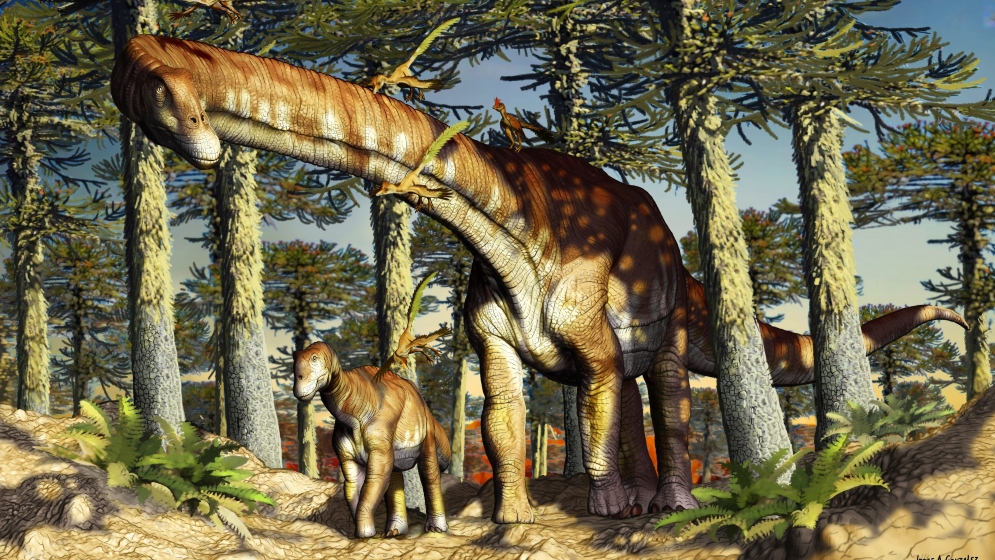It has been 200 years since the English naturalist William Buckland named the first dinosaur to be described: Megalosaurusa carnivore from the Jurassic period, and about 700 species of extinct dinosaurs are already known in the world. If you take a walk around the towns of Cutral Co or Plaza Huinculin the province of Neuquén, people can also be surprised and collaborate with the science of paleontology and find a dinosaur fossil remains.
This situation was what the Vistoso – Oliva family from Cutral Co experienced, who a few meters from their house found a fossil that could be the rib of a herbivore. The piece is already in the Carmen Funes municipal museum and will be part of the collection that the Huinculense institution has.
Gerardo Vistoso lives in the Progreso neighborhood of Cutral Co. “Our lot faces the countryside. We went out for a walk with our two children and the dogs, when my wife and I saw a little stone that could barely be seen over the Plaza Huincul formation,” he explained to RÍO NEGRO Diary.
The man observed that the supposed bone only emerged approximately two centimeters. Then, he returned to his house to look for a chopper and ended up removing it. I thought it was a petrified log. However, to be more certain, she decided to take it to the Carmen Funes municipal museum. so that paleontologists could clarify what it was about.
The honorary director of the entity, Professor Rodolfo Coria, explained that the outcropping in the Huincul formation is common in these two cities and, as urbanization progresses, it is expected that fossil contents will be located.
“It is not uncommon for fossils to be found as logs. Yes, it is rare that bones are found,” he mentioned to RIO NEGRO Diary.
What is done when findings are alerted
Once Vistoso arrived at the institution, the operation was launched to go to the place and explore. “Gerardo told us well where the fossil was. and we scheduled the exploratory excavation to establish if there were more remains”Coria stressed.
As they did the work, they determined what Vistoso and his family had found. “It was a fragment of a rib that was surely dragged by the riverbed. And possibly it is a rib of a Argentinosaurus hbinding. “It is most likely,” she said. A more in-depth study still needs to be done.
“As a paleontological find it is minor, but as Gerardo’s attitude and responsibility it is very important”highlighted paleontologist Coria.
Rodolfo Coria was one of the scientists who described the dinosaur Argentinosaurus huinculensis
The neighbor’s commitment to reporting to the corresponding institution is what adds value to the discovery. “That attitude is what must be rescued,” added Coria.
Par Vistoso, “It was very nice. We were very excited to find something. They told us that rivers used to pass here because they flowed into the Pacific.”
His intention in making the complaint was “so that it could be shown to the community in the museum.”
The paleontology team of the Huinculense museum includes Ludmila Coria, who is the director of the institution, Mateo Gutiérrez who belongs to the Provincial Directorate of Cultural Heritage and Coria himself, who is a professor at the University of Río Negro and honorary director.
The discovery of Guillermo Heredia
EIn 1989, neighbor Guillermo Heredia approached the institution to report that, in his field located in the area known as Las Overas, near Plaza Huincul, there was fossilized material, alarms went off among paleontologists.
The researchers José Bonaparte, from the Argentine Museum of Natural Sciences in Buenos Aires, and Coria himself, made the investigation that led to the first description of Argentinosaurus huinculensisthat means “Argentine reptile from Plaza Huincul”.
It was a herbivorous dinosaur that lived in the range of 97 million years, in the Upper Cretaceous period. Since then, the eyes of the international scientific community have focused on this area because the discovery made it possible to establish that it was a new species and a specimen with an estimated height of 16 meters and a weight in the range of 77 tons. It was one of the largest land animals currently known.
The original femur fossil Argentinosaurus It is on display in the Huinculense house and there is a life-size reconstruction that is the main object of the Paleontology room.
Interaction with the Museum
Coria explained that the population already knows about the museum. “There are constant visits from people who find things in the field and bring them for us to see. But not all that is found are dinosaur fossils. They may also bring fragments of fossil logs and marine mollusks. There is also a lot of consultation by telephone. “We are continually responding to concerns,” he clarified.
The museum reported that every time a complaint occurs, the Ministry of Culture of the Province of Neuquén is informed so that it can issue the permit. Once this step is completed, the excavation begins.
The Tika sphenodont honors the memory of Filomena Ávila, “Doña Tika”, a peasant woman who helped paleontologists in Río Negro
In the case of the fossil that Gerardo found, it was a rib fragment of about 30 centimeters that was conditioned because it was divided into three parts.
Once it is in good condition, it enters the museum’s collection with a photo of the family who found it.
The Carmen Funes museum is located at the entrance to Plaza Huincul, when accessed via national route 22 (in the ejido it is called Córdoba Avenue) and its doors are open from Monday to Monday, from 9 a.m. to 7 p.m.
